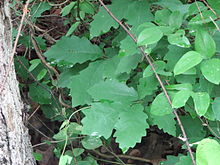- Quercus prinoides
-
Quercus prinoides 
Conservation status Scientific classification Kingdom: Plantae (unranked): Angiosperms (unranked): Eudicots (unranked): Rosids Order: Fagales Family: Fagaceae Genus: Quercus Species: Q. prinoides Binomial name Quercus prinoides
Willd.Quercus prinoides, commonly known as Dwarf Chinkapin Oak, Dwarf Chinquapin Oak, Dwarf Chestnut Oak or Scrub Chestnut Oak, is a shrubby, clone-forming oak native to eastern North America, ranging from Massachusetts to the Carolinian forest zone of southern Ontario to Minnesota, south to North Carolina and Oklahoma.
Contents
Classification and nomenclature
Quercus prinoides was named and described by the German botanist Karl (Carl) Ludwig Willdenow in 1801,[1] in a German journal article by the German-American Pennsylvania botanist Gotthilf Heinrich Ernst Muhlenberg, with the epithet prinoides referring to its resemblance to Quercus prinus, the chestnut oak.
However, this shrubby oak, now generally accepted as a distinct species, is more closely related to chinkapin oak (Quercus muhlenbergii) than to chestnut oak.[1] These two kinds of oak have sometimes been considered to be conspecific (belonging to the same species), in which case the earlier-published name Q. prinoides has priority, with the larger chinkapin oak then usually classified as Quercus prinoides var. acuminata, and the shrubby form as Q. prinoides var. prinoides.
Description
The dwarf chinkapin oak is a large, clonally spreading deciduous shrub or very small tree that typically only grows to 13-20 feet (4-6 m) tall and 13-20 feet (4-6 m) wide.[2] The leaves of dwarf chinkapin oak closely resemble those of chinkapin oak, although they are smaller: 2-6 in (5-15 cm) long, compared to 4-7 in (10-18 cm) long for chinkapin oak. The acorns are 1/2 to 1 in (15-25 mm) long, with the cup enclosing about half of the acorn.[citation needed]
While similar in foliage and fruits, but with smaller leaves, the dwarf chinkapin oak may also be distinguished from the chinkapin oak by differences in growth habit (the clonally spreading shrubby growth form and smaller proportions of dwarf chinkapin oak, even when grown on rich soils) and habitat (the chinkapin oak is typically found on rocky, calcareous sites, while the dwarf chinkapin oak is more typically found on dry, often acidic, sandy soils or dry shales).[1]
Ecology and uses
The acorns of dwarf chinkapin are sweet tasting and relished by humans and many kinds of wildlife. The wood has little commercial value because of the shrub's small size.
References
- ^ a b c "Quercus prinoides". Flora of North America. http://www.efloras.org/florataxon.aspx?flora_id=1&taxon_id=233501075. Retrieved 8 October 2011.
- ^ Hightshoe, G.L. (1988). Native Trees, Shrubs, and Vines for Urban and Rural America. New York: Van Nostrand Reinhold.
Additional references
- Sternberg, G. 1998. Quercus prinoides. 2006 IUCN Red List of Threatened Species. Downloaded on 23 August 2007.

This Fagales article is a stub. You can help Wikipedia by expanding it.

